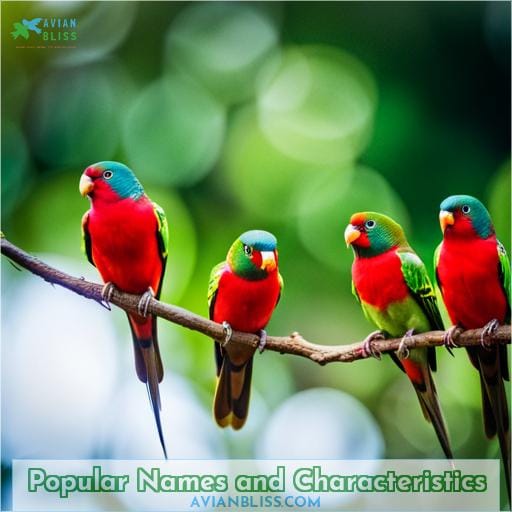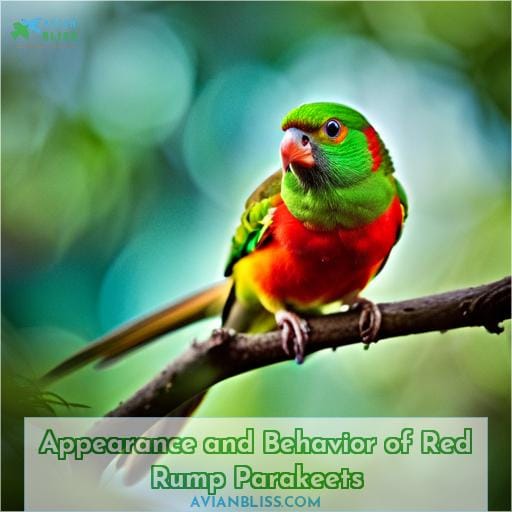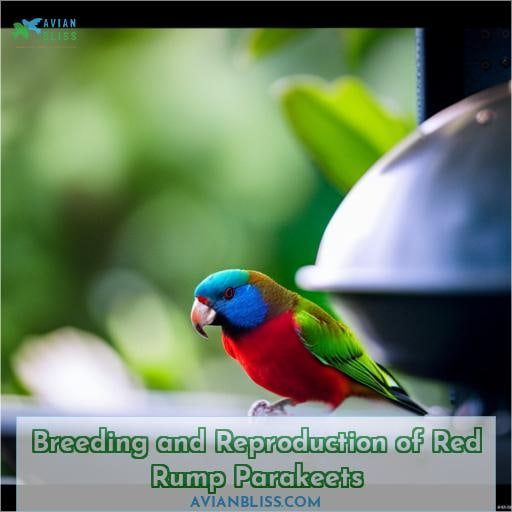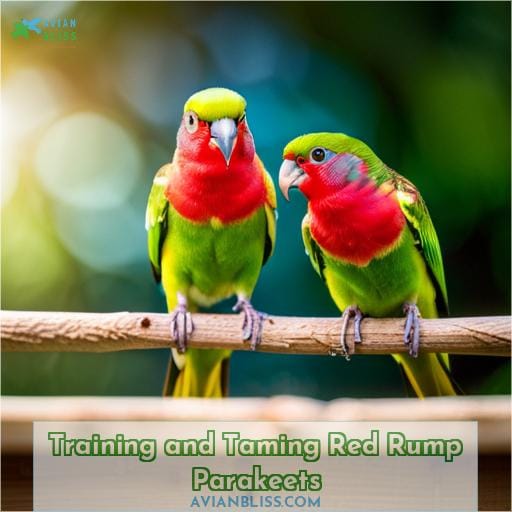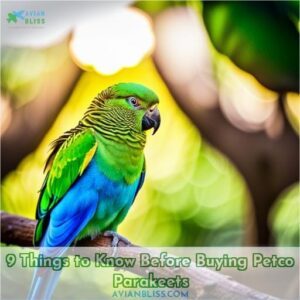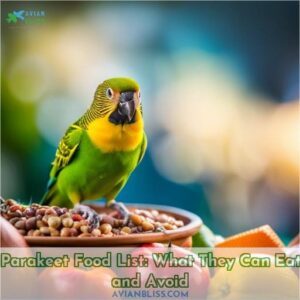This site is supported by our readers. We may earn a commission, at no cost to you, if you purchase through links.
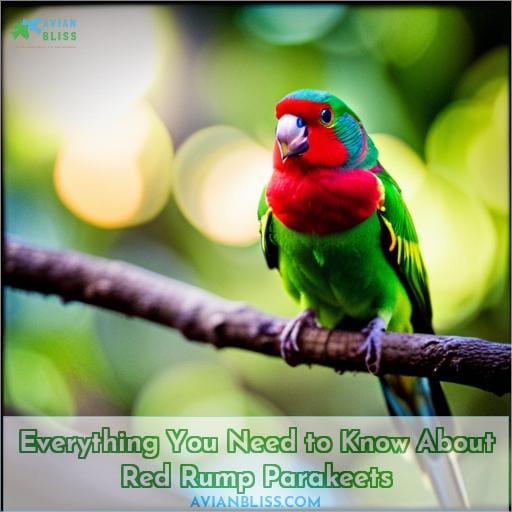 Imagine stepping into a world of vibrant colors and enchanting melodies as you learn everything there is to know about red rump parakeets.
Imagine stepping into a world of vibrant colors and enchanting melodies as you learn everything there is to know about red rump parakeets.
These captivating birds, also known as Red-Backed Parrots or Grass Parrots, are native to south-eastern Australia.
In this article, we’ll explore their origins, characteristics, behavior, and how to care for them properly.
Whether you’re considering bringing one home or simply fascinated by these beautiful creatures,
you’ve come to the right place for all your red rump parakeet knowledge needs.
Table Of Contents
- Key Takeaways
- Description and Origin of Red Rump Parakeets
- Popular Names and Characteristics
- Habitat and Natural Behavior
- Appearance and Behavior of Red Rump Parakeets
- Housing and Care for Red Rump Parakeets
- Breeding and Reproduction of Red Rump Parakeets
- Health and Common Issues in Red Rump Parakeets
- Training and Taming Red Rump Parakeets
- Interacting With Red Rump Parakeets
- Is a Red Rump Parakeet Right for You?
- Frequently Asked Questions (FAQs)
- Can red rump parakeets be trained to talk like other parrot species?
- What are some common health issues that red rump parakeets may face?
- How can I discourage my red rump parakeet from excessive breeding behavior?
- Are red rump parakeets compatible with other types of pet birds?
- What is the average lifespan of a red rump parakeet?
- Conclusion
Key Takeaways
- Red rump parakeets are native to southeastern Australia and are also known as Red-Backed Parrots or Grass Parrots.
- They have vibrant emerald green plumage, red rumps, blue wings, and yellow underparts in males, while females have duller greens and olive underparts.
- Red rump parakeets are highly social birds that live in large flocks or family groups.
- To ensure the health and well-being of red rump parakeets, provide them with a balanced diet, environmental enrichment, regular exercise, and access to veterinary care.
Description and Origin of Red Rump Parakeets
Red Rump Parakeets are known for their vibrant colors and fascinating origin, originating from southeastern Australia. These small parrots have captivated the attention of researchers and bird enthusiasts alike due to their ecological impact, genetic diversity, and intriguing behavioral studies.
The unique regional variations in coloration make them a popular choice among pet bird owners.
In terms of ecological impact, Red Rump Parakeets play a crucial role in seed dispersal through their feeding habits. They contribute to maintaining biodiversity by spreading seeds across different habitats.
Genetic diversity is another significant aspect of these parakeets’ origin. Studies have shown that populations in various regions exhibit distinct characteristics and behavior patterns influenced by environmental factors such as habitat type and availability of food sources.
Behavioral studies on Red Rump Parakeets have shed light on their social dynamics within flocks as well as interactions with other avian species. Researchers continue to uncover new insights into communication methods, mating rituals, territorial behaviors,and flock hierarchy.
Conservation efforts aimed at preserving the natural habitats of Red Rump Parakeet populations are ongoing.Increasing awareness about protecting these birds helps ensure future generations can appreciate their beauty while safeguarding regional variations that add to our understanding of this remarkable species.
Popular Names and Characteristics
Also known as the Red-Backed Parrot or Grass Parrot, this species of parakeet has distinctive characteristics that make it easily recognizable.
Here are three key features and naming traditions associated with Red Rump Parakeets:
- Color Psychology:
The vibrant emerald green plumage of male Red Rump Parakeets isn’t only visually appealing but also reflects their energetic and lively nature.
- Genetic Variations:
While most male Red Rump Parakeets exhibit the iconic red rumps, some individuals may display slight variations in color intensity or patterns due to genetic factors. These subtle differences add an element of uniqueness to each bird’s appearance.
3.Behavioral Studies:
Behavioral studies have shown that these parrots possess excellent avian communication skills through various vocalizations such as chirping and soft call-like songs.They use these sounds to communicate with other members of their flock or express contentment during feeding time.
Understanding the popular names and distinguishing characteristics helps enthusiasts appreciate the beauty and individuality displayed by these captivating birds.
Habitat and Natural Behavior
To understand the habitat and natural behavior of Red Rump Parakeets, it’s important to delve into their preferred environment and inherent tendencies.
These parakeets are native to Australia, where they can be found in:
- Open grasslands
- Lightly timbered plains
- Near rivers
They thrive in these habitats due to their natural foraging instincts and social dynamics within a flock.
Red Rump Parakeets are highly social birds that prefer the company of others. In the wild, they live in large flocks consisting of multiple pairs or family groups. This social nature should be considered when designing an aviary for these birds as it helps promote their overall well-being.
In terms of mating rituals, male Red Rump Parakeets display courtship behaviors such as head bobbing and wing flapping to attract females during breeding season. Environmental enrichment plays a crucial role in stimulating these behaviors by providing opportunities for physical activity and mental stimulation.
Overall, understanding the habitat preferences and natural behavior patterns of Red Rump Parakeets is essential for creating an optimal living environment that supports their physical health and emotional well-being.
Appearance and Behavior of Red Rump Parakeets
When it comes to the appearance of Red Rump Parakeets, their physical attributes and color variations are quite remarkable.
These medium-sized parakeets showcase bright emerald green plumage in males, with a striking red rump, blue wings, and yellow underparts.
Females have a more subdued look with dull green backs, olive underparts, and dark blue wingtips.
In terms of behavior, Red Rump Parakeets are known for their social nature and ability to interact well with humans.
They can be energetic explorers who enjoy mental stimulation through toys and attention from their owners.
Additionally, they communicate using a balanced mix of soft call-like songs rather than skilled talking abilities.
Physical Attributes and Color Variations
One notable aspect of Red Rump Parakeets is their distinct physical attributes and color variations.
- Color Genetics: Different combinations produce a range of plumage variations.
-
Plumage Variations:
- Males have bright emerald green bodies, red rumps, blue wings, and yellow underparts;
- Females exhibit duller greens with olive underparts and dark blue wingtips.
- Breeding Challenges: Selective pairing ensures desired traits while avoiding genetic health issues.
- Visual Identification: Observing these unique physical features aids in identifying individual birds accurately.
Social Behavior and Interaction With Humans
When interacting with Red Rump Parakeets, you’ll notice the fascinating aspects of their social behavior and how effortlessly they engage in interactions with humans.
As experts in avian care, we understand the importance of bird bonding for both the well-being of these beautiful creatures and our own enjoyment as pet owners.
By recognizing communication cues unique to red rump parakeets through observation combined with specialized training techniques tailored specifically for overcoming potential fears or challenges associated during early stages of interaction; successful human-bird relationships can easily be established.
So if you’re considering adopting a red rump parakeet into your family dynamic—a decision that requires careful consideration—you can rest assured knowing that these birds possess an inherent suitability for such companionship due to their inherently sociable disposition.
Vocalizations and Communication
As you observe the appearance and behavior of Red Rump Parakeets, their vocalizations and communication become evident.
These parakeets engage in chirping to communicate with each other and establish social interaction.
Understanding their vocalization patterns is crucial for effective mimicry training.
However, it’s important to note that they can be territorial, which may pose some challenges in certain situations.
Housing and Care for Red Rump Parakeets
To ensure the well-being of your Red Rump Parakeet, it’s important to provide a suitable cage size and setup.
The recommended dimensions for their cage should allow ample space for movement and exercise.
Additionally, a balanced diet consisting of nutritious food and environmental enrichment activities are crucial for their overall care.
Suitable Cage Size and Setup
To ensure the comfort and well-being of your Red Rump Parakeet, it’s essential to provide a cage that’s appropriately sized and properly set up.
The key to creating an optimal living environment for these vibrant birds lies in understanding their natural behavior.
When it comes to suitable cage size for red rump parakeets or any other similar species like mulga parakeets or quaker parakeets (also known as monk parrots), bigger is always better.
These active creatures need plenty of space to fly around freely without feeling cramped or restricted in movement.
In terms of dimensions, consider providing a minimum width measuring 1-2 feet wide along with sufficient height ranging from 3-4 feet tall so they can stretch their wings fully without any hindrance.
A depth measurement between 1-2 feet would allow ample room for perches at different levels within the enclosure.
It’s important not only to focus on size but also pay attention to setting up an enriching environment inside the birdcage by incorporating various elements such as:
- Perch variety offering different textures (e.g., wooden branches) which helps keep nails trimmed naturally through constant gripping during playtime;
- Climbing options like ladders encourage physical activity promoting muscle development while adding fun;
- Hiding places such as small cozy hideouts create safe spaces where they can retreat when feeling overwhelmed—these additions enhance overall psychological well-being ensuring happy pet companionship!
Remember that red rump parrots are highly intelligent beings who thrive on mental stimulation just as much as physical exercise.
Providing them with enriching activities like puzzle toys, foraging opportunities, and interactive playthings will keep their minds engaged and prevent boredom.
In conclusion, when setting up a cage for your red rump parakeets or any similar species such as mulga parakeets or quaker parakeets (monk parrots), prioritize appropriate sizing to accommodate their active nature while also incorporating various elements that promote physical activity and mental stimulation.
By providing the right environment through suitable cage size and setup along with enrichment activities like perch variety, climbing options, playful hideouts—you can ensure the well-being of these beautiful birds under your care.
Recommended Diet and Nutrition
For optimal health and well-being, provide your Red Rump Parakeet with a balanced diet of fresh fruits, vegetables, seeds, and high-quality pellets.
Incorporate these key components into their feeding schedule to meet their dietary preferences:
- A variety of fresh fruits like apples or berries
- Nutritious vegetables such as carrots or leafy greens
- High-quality seed mixtures for added nutrients
- Pellets specifically formulated for parakeets’ nutritional needs
Environmental Enrichment and Exercise
Creating a stimulating environment and providing ample opportunities for exercise are essential aspects of caring for Red Rump Parakeets.
To keep them mentally and physically engaged, set up their cage with various toys, perches of different sizes, and interactive puzzles.
Incorporate stimulating activities such as hanging mirrors or bells, rotating toys regularly to prevent boredom.
Regular playtime outside the cage is crucial to ensure they get enough exercise and social interaction with you.
Breeding and Reproduction of Red Rump Parakeets
When it comes to breeding and reproduction, there are several important factors to consider for Red Rump Parakeets.
First, understanding the appropriate breeding age is crucial for successful reproduction.
Additionally, knowing about nesting requirements and behavior can help create a suitable environment for mating and egg-laying.
Finally, being aware of the incubation period and how to care for chicks once they hatch is essential in ensuring their health and survival as they grow.
Breeding Age and Considerations
Breeding age and considerations play a crucial role in the successful reproduction of Red Rump Parakeets.
Challenges arise as females age, impacting their egg-laying ability and overall health.
Health risks from frequent egg laying include calcium deficiencies.
Safe breeding strategies involve monitoring egg-laying frequency, implementing light control, and diet changes to ensure successful aging without compromising reproductive health.
Nesting Requirements and Behavior
To ensure successful breeding and reproduction, understand the nesting behavior and requirements of Red Rump Parakeets.
These parakeets exhibit unique mating rituals, such as courtship displays and mutual preening.
They prefer nest boxes with specific dimensions for comfort and security during breeding.
After laying eggs, both parents provide diligent parental care until the chicks fledge from the nest.
Incubation Period and Caring for Chicks
During the incubation period, provide proper care and attention to ensure the health of your Red Rump Parakeet chicks.
Understand incubation techniques, monitor chick development milestones, and be aware of nesting challenges.
Parental involvement is crucial for their growth and well-being.
Stay vigilant in providing a nurturing environment for successful hatching and healthy chick development.
Health and Common Issues in Red Rump Parakeets
As a responsible owner, it’s crucial to prioritize the health of your Red Rump Parakeet. Understanding the signs of a healthy bird, common health problems, and preventive measures can help you ensure their well-being.
Regular veterinary care and check-ups are essential in maintaining optimal health for your feathered friend.
Signs of a Healthy Bird
When caring for a Red Rump Parakeet, it’s important to be able to recognize the signs of a healthy bird.
Observing behavior, dietary indicators, feather condition, vocalization patterns, and interaction cues can all provide valuable insights into your parakeet’s well-being.
By paying attention to these factors, you can ensure that your feathered friend stays happy and thriving.
Common Health Problems and Prevention
Are you concerned about the common health problems that can affect Red Rump Parakeets and how to prevent them?
Preventive care is crucial in ensuring the well-being of your feathered friend. Regular health check-ups, following dietary guidelines, and implementing wellness practices can help identify and address common ailments early on, promoting a long and healthy life for your beloved parakeet.
Veterinary Care and Regular Check-ups
To ensure the health and well-being of your Red Rump Parakeet, regular veterinary care and check-ups are essential.
Veterinary preventive care plays a crucial role in:
- Monitoring their overall health
- Conducting wellness check-ups
- Preventing diseases
By prioritizing avian healthcare for your parakeet, you can provide them with the necessary support to thrive in their environment.
Training and Taming Red Rump Parakeets
When it comes to training and taming Red Rump Parakeets, building a strong bond and establishing trust is essential.
Basic training commands and tricks can be taught through positive reinforcement techniques, rewarding desired behaviors with treats or praise.
Handling and socializing techniques should be employed gradually, allowing the parakeet to become comfortable with human interaction at their own pace.
Bonding and Building Trust
To build a strong bond with your Red Rump Parakeet, focus on bonding and building trust through training and taming.
Bonding activities like spending quality time together and offering treats can help establish trust. Trust-building exercises include hand-feeding, gentle handling, and allowing the bird to explore its surroundings under supervision.
Bonding Activities for Building Trust:
- Spending Quality Time Together
- Offering Treats as Rewards
- Hand Feeding to Create Positive Associations
- Gentle Handling with Patience
- Allowing Supervised Exploration
Basic Training Commands and Tricks
How can you train and teach tricks to your Red Rump Parakeet?
Trick training is an excellent way to bond with your feathered friend.
Start by establishing a strong foundation of trust through bonding techniques.
Once trust is established, gradually introduce basic commands and tricks such as step-up, turn around, or targeting objects.
Patience and consistency are key in overcoming behavioral challenges during the taming progress.
Handling and Socializing Techniques
When training and taming your Red Rump Parakeet, it’s important to establish a strong bond through proper handling and socialization techniques.
- Use gentle touch and positive reinforcement during handling.
- Gradually introduce interactive play sessions for bonding opportunities.
- Provide a calm environment with consistent routines to promote comfort and security.
Establishing a strong bond with your Red Rump Parakeet is crucial for successful training and taming endeavors. By utilizing effective handling skills, implementing socialization tips, and incorporating interactive play in the right way, you can build trust between yourself and your parakeet companion.
Bonding Techniques
When it comes to establishing trust with your Red Rump Parakeet, using gentle touch is paramount. Begin by allowing them time outside of their cage in an enclosed area where they feel safe but have room for exploration under supervision.
Socialization Tips
Socializing plays a vital role in helping these birds acclimate comfortably into human environments while reducing stress levels associated with new surroundings or interactions that may be perceived as threats initially. Start by spending quality time near their cage daily without direct contact until they become accustomed to seeing you regularly.
Handling Skills
Properly handling these parrots requires patience, consistency, respect, and understanding their body language cues. Begin by offering treats from the palm of your hand inside the cage; once comfortable eating from there step up onto fingers gently moving forward towards perching on shoulders or hands if desired.
Building mutual trust takes time when interacting, learn at each bird’s pace always remembering every interaction counts towards creating stronger bonds over period together spent enjoying companionship found within relationship formed between owner pet avian species.
Interacting With Red Rump Parakeets
When it comes to interacting with Red Rump Parakeets, playtime and mental stimulation are crucial for their overall well-being.
These active birds thrive on engagement and require toys and activities that keep them mentally stimulated.
By spending quality time with your parakeet, playing games, providing interactive toys, and creating a bond of trust through gentle handling, you can establish a strong relationship with your feathered friend.
Playtime and Mental Stimulation
To keep your Red Rump Parakeet happy and mentally stimulated, engage in regular playtime with them.
Provide enrichment activities, such as cognitive challenges and interactive play sessions.
Offer stimulating toys that encourage exploration and engagement.
Incorporate engaging exercises into their daily routine to promote physical activity and mental stimulation for a well-rounded experience.
Toys and Activities to Keep Them Engaged
To keep your Red Rump Parakeet engaged and entertained, provide them with a variety of toys and activities.
Enrichment games, puzzle toys, foraging fun, DIY challenges, and interactive play are all essential for their mental stimulation.
These activities won’t only prevent boredom but also promote their cognitive development while ensuring they stay happy and active.
Enjoying Their Company and Creating a Bond
To enjoy the company of your Red Rump Parakeet and create a strong bond, regularly engage in interactive activities with them.
- Build trust through gentle handling and positive reinforcement.
- Encourage playful engagement with toys and games that stimulate their curiosity.
- Develop communication skills by teaching basic commands or tricks.
- Cherish bonding moments through shared activities like training sessions or leisurely walks around the house.
Is a Red Rump Parakeet Right for You?
Is a Red Rump Parakeet the right pet for you?
Before making this decision, there are several important considerations to keep in mind.
First and foremost, owning a parakeet requires a significant time commitment and daily care.
From feeding and cleaning to providing mental stimulation, these birds thrive on interaction and attention.
Understanding the responsibilities of ownership is crucial to ensure that you can provide the necessary care for your feathered friend.
Considerations Before Getting a Red Rump Parakeet
Before bringing a Red Rump Parakeet into your home, it’s important to consider if this colorful and energetic bird is the right fit for you.
- Egg-laying challenges
- Breeding age
- Reproductive health issues
- Managing breeding behaviors
- Implementing safe breeding strategies
Understanding these factors will ensure a successful and healthy experience with your new feathered friend.
Time Commitment and Daily Care
Considering the time commitment and daily care required, owning a Red Rump Parakeet is an engaging responsibility that can bring joy and fulfillment to your life.
Proper time management is essential for routine maintenance, including:
- Feeding
- Cleaning the cage
- Providing mental stimulation through daily interactions.
Balancing work-life commitments ensures a harmonious relationship with your feathered friend.
Understanding the Responsibilities of Ownership
If you’re looking for a pet that requires minimal time and effort, a Red Rump Parakeet may be the perfect choice for you. As an owner, it’s important to understand your responsibilities and commit to meeting their care demands.
Owning a Red Rump Parakeet means:
- Taking accountability for their well-being
- Providing proper nutrition
- Exercise
- Mental stimulation
- Ensuring expectation clarity in terms of time commitment and daily care
Frequently Asked Questions (FAQs)
Can red rump parakeets be trained to talk like other parrot species?
Red rump parakeets, while not skilled talkers like some other parrot species, can learn to mimic sounds and even a few words with patient training.
What are some common health issues that red rump parakeets may face?
Red rump parakeets may face health issues such as tumors and liver problems.
These pesky predicaments can be prevented by providing:
- regular exercise
- attention
- a balanced diet
How can I discourage my red rump parakeet from excessive breeding behavior?
To discourage excessive breeding behavior in your red rump parakeet, consider:
- Not providing nest boxes
- Monitoring their egg-laying frequency and health
- Environmental changes
- Consulting with an avian vet if needed.
Are red rump parakeets compatible with other types of pet birds?
Red rump parakeets are best kept with their own kind due to territorial tendencies, like a vigilant sentinel guarding its territory.
What is the average lifespan of a red rump parakeet?
The average lifespan of a red rump parakeet is approximately 8-12 years.
With proper care, attention, and a suitable environment, these vibrant birds can provide you with companionship for several joyful years.
Conclusion
To enter the world of red rump parakeets is to step into a realm of vibrant colors and enchanting melodies.
These captivating birds from south-eastern Australia, also known as Red-Backed Parrots or Grass Parrots, possess a unique charm that’s hard to resist.
From their striking physical attributes and social behavior to their care requirements and training potential, red rump parakeets offer a delightful experience for any bird enthusiast.
Before deciding to bring one home, consider the responsibilities and time commitment involved, but rest assured that the joy and companionship they provide make it all worthwhile.


